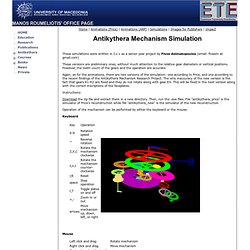

Polymers: A Properties Database. Robotics general. Automation. DIY Electronics. IEA - Home. All About Circuits Forum - Powered by vBulletin. Hack a Day. Free Electronic Circuit Collection of 30,000 + electronic schematics to solve design problems. Arduino - HomePage. Electronics Demonstrations. Fritzing. Harraste Elektroniikka. EDN. Practical tech. Sheldon Brown's Home Page. Bicycling. Dan's Workshop Blog. Science Toys and gadgets building. Learn morse code. Hands On Science - Journal. Image Scan Sequencer. PDF Pad. Printable Paper. Material Properties Database. The Ultimate Online Reference for Engineers.
What's That Stuff? You might ask yourself...

What's That Stuff? Ever wondered about what's really in hair coloring, Silly Putty, Cheese Wiz, artificial snow, or self-tanners? C&EN presents a collection of articles that gives you a look at the chemistry behind a wide variety of everyday products. Sort: Alphabetically (Text Only) | Most Recent. Animated Engines - Home. 507 Mechanical Movements.
Product reviews and prices, software downloads, and tech news - TNW is the International Source for Internet News, Business and Culture. The Engineer's Ultimate Resource Tool. IEEE Spectrum Online: Technology, Engineering, and Science News. Fuel Cells 2000 : Fuel Cell Basics : How They Work. A fuel cell is an electrochemical device that combines hydrogen and oxygen to produce electricity, with water and heat as its by-product.

In its simplest form, a single fuel cell consists of two electrodes - an anode and a cathode - with an electrolyte between them. At the anode, hydrogen reacts with a catalyst, creating a positively charged ion and a negatively charged electron. The proton then passes through the electrolyte, while the electron travels through a circuit, creating a current. At the cathode, oxygen reacts with the ion and electron, forming water and useful heat. This single cell generates about 0.7 volts, just about enough to power a single light bulb. There are many different Types of Fuel Cells, each with their own unique operating characteristics.
Since fuel cells rely on an electrochemical process and not combustion, emissions from fuel cells are significantly lower than emissions from even the cleanest fuel combustion processes. Battery Life in Gadgets - The Science of Battery Life in Electronics. The proof, to me, was irrefutable. I had bought a new iPod within weeks of my coworker: the same generation player, running on the same lithium-ion (li-ion) cobalt oxide battery. She plugged it into her computer every day to get to her music. That seemed like an astonishing mistake—obviously, her iPod's battery would suffer, since it would cycle every day, multiple times during each 8, 10 or 12-hour workday. My player, which I ran down completely before each charge, would burn less cycles, and retain more power in the long run. A year later, her iPod could barely squeak through a subway ride from Brooklyn to Midtown Manhattan. Forget for the moment that I was wrong.
And yet, consumer electronics companies offers no true consensus on how to hold off battery death, and the Internet only deepens the confusion. Forget the Number of Cycles Tests have shown that raising the voltage of some li-ion cells by a tenth of a volt, from 4.1 V to 4.2 V, will cut its lifespan in half over time.
Antikythera Mechanism Simulation. These simulations were written in C++ as a senior year project by Fivos Asimakopoulos (email: fivasim at gmail.com) These versions are preliminary ones, without much attention to the relative gear diameters or vertical positions.

However, the teeth count of the gears and the operation are accurate. Again, as for the animations, there are two versions of the simulation: one according to Price, and one according to the recent findings of the Antikythera Mechanism Research Project. The only inaccuracy of the new version is the fact that gears K1-K2 are fixed and they do not rotate along with gear E4. This will be fixed in the next version along with the correct inscriptions of the faceplates. Instructions: Download the zip file and extract them in a new directory. Hublot painstakingly recreates a mysterious, 2,100-year-old clockwork relic - but why? Why on Earth would you want to strap one of these to your wrist?

It barely tells the time, and it can't take pictures, tweet or connect to your Facebook. In fact, very few people would have the faintest idea what it is, or why you'd want one at all. But for those that do recognize its intricate gears and dials, this tiny, complex piece of machinery tells a vivid and incredible tale. It's a story of gigantic scientific upheaval, of adventure and shipwreck on the high seas, of war and death. A story of amazing intellect, lost riches and impossible chance - a sunken treasure that Jaques Cousteau once described as "more valuable than the Mona Lisa" - and it's connected with an ancient celebrity whose star shone so brightly that he's still a household name more than 2200 years after his death...
Oldest computer made from Lego. The Plastics Historical Society. Medieval Technology Pages. The Medieval Technology Pages The Medieval Technology Pages are an attempt to provide accurate, referenced information on technological innovation and related subjects in western Europe during the Middle Ages. There are several ways to access this information. The most direct method is through the Subject Index which provides direct access to all the technology pages. Many of the articles are also present in a historical Timeline. And material can be found by examining the References which back-reference all articles through the sources used.
Subject Index References Timeline It is difficult to provide useful information on Medieval Technology. The information contained on these pages has been gleaned from a variety of places, most often secondary sources.